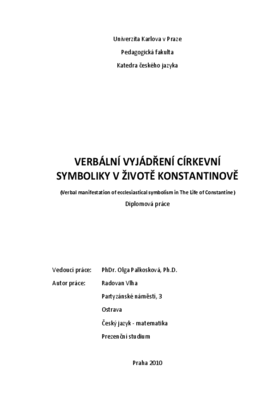Verbální vyjádření církevní symboliky v životě Konstantinově
Verbal manifestation of ecclesiatical symbolism in The Life of Constantine
diplomová práce (OBHÁJENO)

Zobrazit/
Trvalý odkaz
http://hdl.handle.net/20.500.11956/22302Identifikátory
SIS: 86974
Kolekce
- Kvalifikační práce [19358]
Autor
Vedoucí práce
Oponent práce
Šmejkalová, Martina
Fakulta / součást
Pedagogická fakulta
Obor
Učitelství všeobecně vzdělávacích předmětů pro základní školy a střední školy český jazyk - matematika
Katedra / ústav / klinika
Katedra českého jazyka
Datum obhajoby
27. 5. 2010
Nakladatel
Univerzita Karlova, Pedagogická fakultaJazyk
Čeština
Známka
Výborně
Verbal manifestation of ecclesiastical symbolism in The Life of Constantine At the beginning of this thesis we become acquainted with a numerical symbolism that is clarified from two different points of view; the ecclesiastical symbolism and the history that differentiates the real historical events from the moments meant solely for the reader accustomed to Byzantine literature of the ninth century. After the introduction we apply ourselves to a chronological analysis of the text. The historical facts elucidating the use of the clauses written by the author of The Live of Constantine are always thoroughly analysed. The main part of the text focuses on three disputations representing a logical complex culminating in the last disputation. This last disputation defends the use of the Slavic language in liturgy. A political situation on the Byzantine throne and both the Constantinople and the Roman papal throne is explained in the thesis. Moreover, the reason why Rostislav the prince of Great Moravia asked for priests from the Byzantine Empire and not from Rome, and why did Byzantium, at least partially, grant his request. We will then learn what theological dangers Constantine faced while creating the new writing system and translating the Bible into the Old Church Slavonic. The text also concentrates on the...
